By Sherri Shields
May 28, 2015
It’s a growing phenomenon in Florida! From the Panhandle to the Keys, EnergyWhiz is drawing in students fascinated with renewable energy technology.
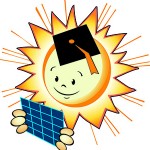
EnergyWhiz, which includes six separate competitions, is a venue for students in grades fourth through 12th to demonstrate their science, technology, engineering, art and mathematics capabilities through hands-on, energy-focused competitions. At this year’s 13th annual event on May 2, more than 650 energized students from across Florida converged at the University of Central Florida’s FSEC in Cocoa to showcase their renewable energy projects and participate in the competitions. “We like making things run on the sun,” said Conner Dale, a student from Edgewood Junior Senior High. “It’s fun to interact with other students from across the state,” added Raydn Hall.
Tallahassee, Gainesville and Orlando hosted smaller EnergyWhiz Expos this year, leading up to the major EnergyWhiz event. “In an effort to reach more students, we’re encouraging teachers across Florida to host regional EnergyWhiz Expos, and then the winners of the expos will advance to the state level and compete at FSEC,” said Susan Schleith, K-12 education director at FSEC.
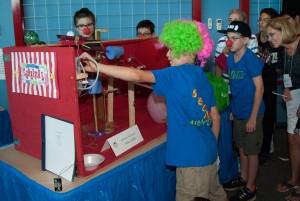
A popular event of the day, which had three times more participants than last year, was the Hydrogen Challenge. It’s a hands-on engineering challenge for middle and high school students, where students demonstrate an understanding of hydrogen through a creative timing contraption built with several Rube Goldberg-type steps. The challenge requires multiple energy transfers, in which one step utilizes a fuel cell, and must finish within two minutes.

New to EnergyWhiz this year is the Hydrogen Horizon Automotive Challenge, where student teams build and race a 1:10 scaled remote controlled, hydrogen fuel cell car. This six-hour race, in which students strive to complete the most laps, is a modified version of the 24-hour de St. Jo race held in France. “EnergyWhiz was a perfect venue to bring this competition to the United States and get schools involved,” said Timo Lukkarinen, chief executive officer of Horizon Educational, sponsor of the fuel cell cars and event organizer. “This was a good first step. Ultimately, we want to get the students involved at all levels, from design concept to protoyping to testing to manufacturing,” said Lukkarinen.
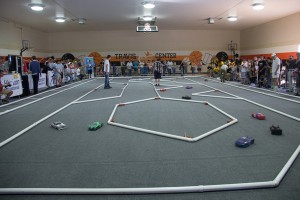
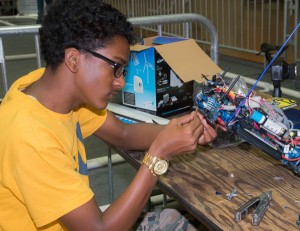
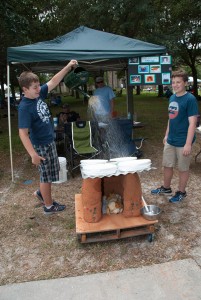
Getting students to learn about energy-efficient and eco-friendly building design is the primary focus of the Critter Comfort Cottage. One middle school team demonstrated that cob—a mixture of clay, sand, and straw—is a feasible building material. The Cob Critter Cottage incorporated a rust-proof stainless steel roof, a rainwater catcher, and also a solar exhaust fan.
“Our cob critter cottage was fun to make and the materials were easy to come by,” said Ethan May from Hidden Oaks Middle School in Stuart, Fla. The Cob Critter Cottage won first place in the middle school division.
Blue skies, minimal clouds and a slight breeze provided ideal conditions for the day, and especially for the solar projects.
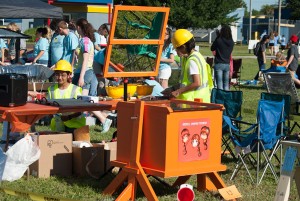
The Bright House Solar Energy Cookoff challenges students in grades fourth through 12th to design and build solar cookers, and cook a recipe of their own creation using the power of the sun. In Top Chef-style, a panel of experts judge each dish based on taste, ingredients and creativity.
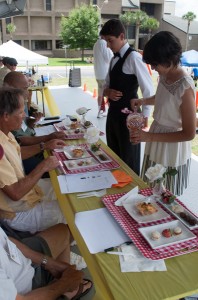
The Solar Sizzlers from Newberry Elementary earned a first place culinary award in the Yellow Division for their solar garden soup, seabiscuit with garlic parsley butter, and baked apples with craisin crumb topping. They also won a third place award for Best Design, and the WOW! Award.
EnergyWhiz’s flagship event, the Junior Solar Sprint, challenges middle-school students to design, build and race model solar cars. Awards are given based on vehicle design, quality of craftsmanship, innovation and vehicle speed.
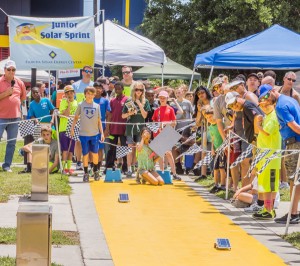
Team “Vibot 8” from Brandon Robotics Academy in Brandon, Fla. was the fastest on the track in the Blue Division, and they also won first place for the Best Design.
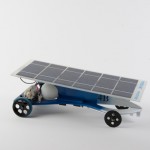
The Energy Innovations competition, where student teams use a full-scale solar electric (photovoltaic) panel to design and market a product or artistic work, inspires real-world energy solutions. A high school team from Cape Coral earned a WOW! Award and second place for their solar-powered waste water treatment plant.
Addressing the requirement for fish farmers to properly dispose of fish effluent, Island Coast High School’s team developed the Super Suk-A-Poop. Fish waste water is passed through a dual screen filter system where the solids are collected and dried in a solar oven. Once the waste is dried, it is pulverized for organic fertilizer. The Super Suk-A-Poop collects the remaining waste water, and the liquid fertilizer is transferred to various hydroponic systems to grow vegetables.
Responsible for the electrical and some engineering, team member Noah Pegg said this project has changed his future plans. “I’ve changed my thought of majoring in criminal justice to now biology with a focus in environmental studies. My goal is to eventually own an aquaculture facility.”

This innovative solution of recovering wastewater and producing organic fertilizer, while utilizing solar, is a sustainable solution. “Our motto is to not only leave the world at least as good as you find it, but leave the world better for future generations,” said Pegg.
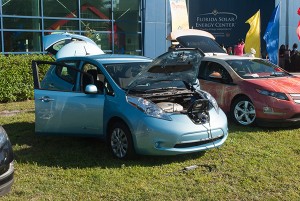
“As our educational events continue to expand and reach students statewide, we are seeking new sponsorships. Our partnership with Brevard County Parks and Recreation this year allowed us to have an awesome outdoor stage, the opportunity to host the Hydrogen Horizon Automotive Challenge next door at Travis Park, and host food vendors and exhibitors,” said Schleith.
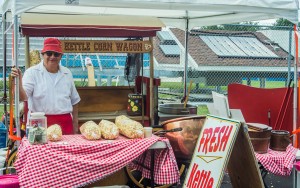
A photo gallery of all events at EnergyWhiz 2015 can be seen at: http://fsec.zenfolio.com/ew2015.
A list of all the winners can be seen at: https://blog.energyresearch.ucf.edu/2015/05/2015-energywhiz-winners/
For more information about EnergyWhiz, visit http://www.fsec.ucf.edu/go/energywhiz or contact Susan Schleith, K-12 Education Director, at susan@fsec.ucf.edu or Sherri Shields, Communications Director, at sherri@fsec.ucf.edu.
###
PR15-06
excellant,
We need the next generation to look after the environment and invent new way of renewable energy sources.
regards,